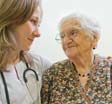
Dehydration can be particularly dangerous for seniors; learn how to keep older loved ones hydrated.
Thirst perception
In many older people, certain neurological receptors lose sensitivity, and therefore an individual may lose his or her ability to perceive thirst. Even when fluid levels have dropped dangerously low, the person simply may not feel thirsty at all. That's why it's especially important to keep up a regular hydration schedule and not rely on thirst as an indicator of the need to drink.
Medication side effects
Some of the most commonly prescribed medicines for conditions suffered by older people can increase the risk of dehydration. Other medications and conditions can lead to difficulty swallowing. At the same time, the kidneys are losing their ability to concentrate urine, so patients may be urinating the same amount whether or not they are drinking plenty of water.
Incontinence and ambulation
Another factor that can contribute to dehydration among the elderly is related to incontinence. If people are anxious about incontinence, they may intentionally drink less water to reduce the number of times they need to use the bathroom. This problem can be even more pronounced if the older person lives in a facility where he or she has to depend on others to get to the bathroom.
Dangerous consequences
When elderly people do not get enough water, the results can be catastrophic for their health. In a very short period of time, they can experience serious changes in mental state, become lethargic or incoherent. If the problem is not corrected quickly, they can experience seizures, acute kidney failure and even cardiovascular collapse. So how can caregivers make sure older people are getting enough fluid?
Goals and schedules
Working with a doctor who knows your loved one's medical history, decide on an individualized goal for daily fluid intake. This process may include measuring daily intake of fluids and output of urine and measuring important chemical levels in the body. Once you have established how much water the patient should be getting every day, set a schedule for drinking liquids. It may be helpful to drink water before or after regularly scheduled activities like walks or administering medications so that drinking becomes habitual.
Personal preferences
Make sure to offer beverages at different temperatures and in varied flavors. Popsicles, soups and fruits and vegetables that contain lots of water are also good options for increasing daily fluid intake. And it may also be useful to use cups or straws that make drinking easier.
Getting to the restroom
If incontinence has created difficulties or there are mobility issues, make sure to schedule regular trips to the restroom to keep the older person comfortable. If he or she is able to get to the restroom independently, clear the pathway of obstacles. It may also be wise to limit caffeinated or carbonated beverages, which can cause additional trips or an uncomfortable sense of urgency. Talk to a medical professional about pelvic floor exercises, medications or protective garments that may make things easier.
"If an older person in your life is struggling to get enough water this summer, talk to the healthcare professionals who are helping you," says Salisbury for PruittHealth. "Create a multi-faceted plan to keep fluids flowing. Knowing the risks and taking extra steps will prevent a serious health crisis."

.png)
